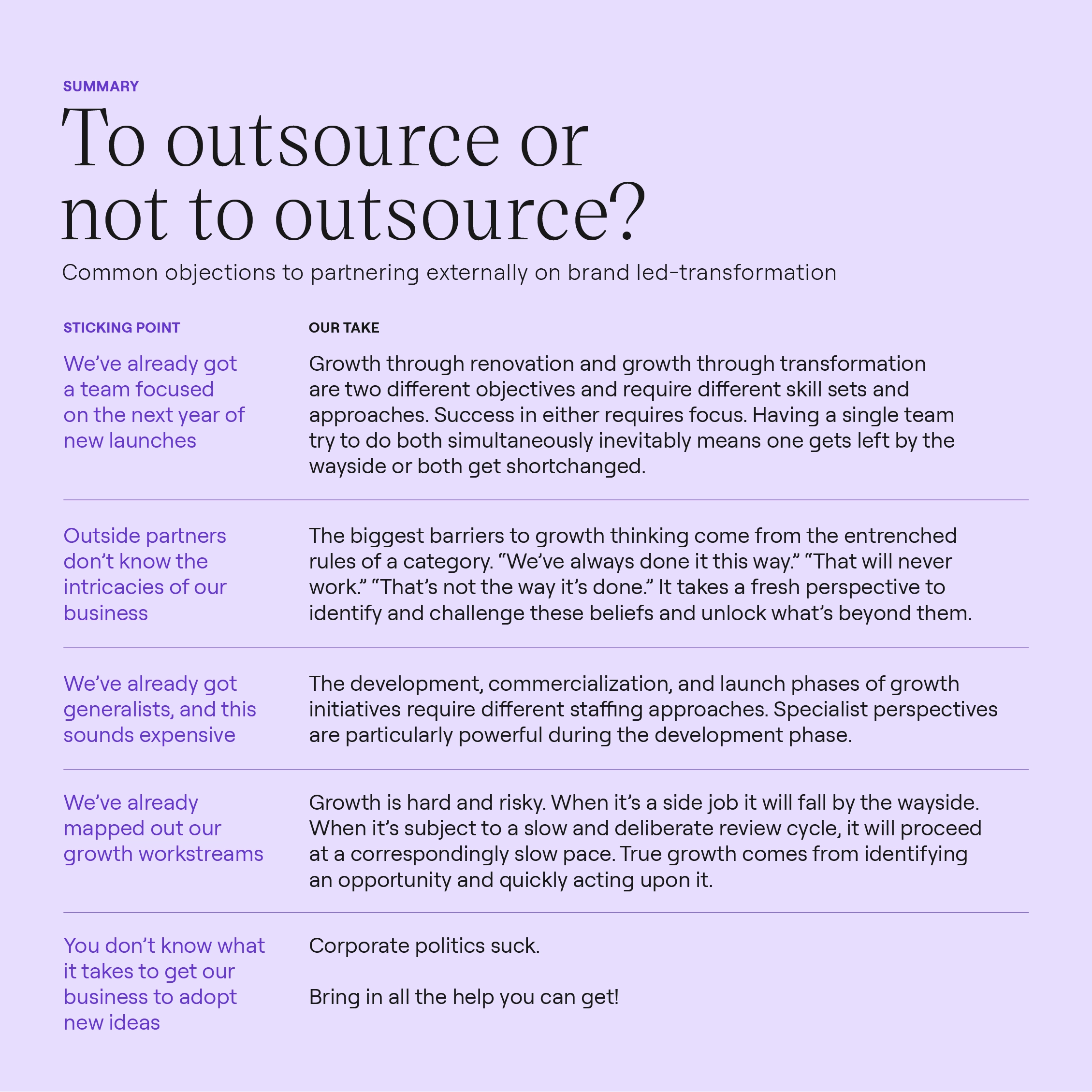July 11, 2024
Why supercharging innovation requires external partners

When it comes to enhancing innovation and crafting exceptional customer experiences, the decision to hire external innovation and experience design teams can be a game-changer for your organization.
You may be thinking, “we already have an internal team that does experience and innovation,” but hear us out: an outside partner can advance and accelerate your growth plans.
Now you’re probably asking: isn’t this a breeding ground for competition or duplication of efforts? The truth is, it's all about strategically augmenting your team's capabilities. Leading companies like Slack and Google do it. You can, too. You can engage in thoughtful collaborations to amplify your strengths and cover your bases more efficiently.
For example, Nestle approached us a few years back because they felt they were missing out on the macro-shifts that were changing the way consumers shopped for groceries and fed their families. They had world-class teams working within each of the brands on the next big thing for HotPockets (hot and spicy pockets!) or the up-and-coming flavors for Haagen-Dazs (alcohol infusions!), but were missing the larger, broad reaching opportunities that could reframe the entire product portfolio, like alternative proteins / dairies and clean ingredient panels. Becoming known as a leader in quality food and its impact on families was going to take portfolio-level innovation and experience thinking, and it took having a growth partner enable them to see across categories, ask the difficult questions, get to the forward-looking macro-trends, create a pipeline of new ideas that spanned and connected product categories, and build the internal infrastructure to be able to maintain this momentum.
So, how do you ensure growth partnerships foster innovation?
Let’s explore the most common sticking points around hiring external partners, why they shouldn’t stand in the way of seeking outside talent, and how to pair in-house with external teams to supercharge innovation and experience success.
Sticking point: We’ve already got a team focused on the next year of new launches
Our take: Growth through renovation and growth through transformation are two different objectives and require different skill sets and approaches. Success in either requires focus. Having a single team try to do both simultaneously inevitably means one gets left by the wayside or both get shortchanged.
This is the most common sticking point we hear. Clients often have innovation and experience teams who are hard at work planning the next wave of ideas. While essential for incremental growth, this approach runs the risk of leaving bigger growth opportunities on the table.
Hill’s Pet Nutrition, a leading pet food manufacturer, enlisted our help when it was looking to enter an entirely new product category. By engaging with an outside partner, the internal team was able to focus their efforts on the initial market launch while our team focused on the long-term value proposition and overarching plan for category growth. The workstreams were complementary, but distinct, enabling Hill’s to think about the immediate steps to take as well as the longer-term strategic ambition, all at the same time.
A solid growth roadmap will naturally include near-in, incremental initiatives as well as longer-term, more speculative and disruptive initiatives. We find our clients’ growth teams are great at identifying, planning for and sustaining the innovation their businesses require. The teams are familiar with their customers’ preferences, needs, and frustrations. They are closely connected to internal R&D teams, product teams, and reams of historical data. From this vantage point, they are best suited to optimize and build for the near term.
Meanwhile, an outside perspective can turbocharge growth by taking a longer-term perspective. Outside growth partners are unencumbered by the existing offerings and instead can set their sights on developing new value propositions, identifying emerging customer needs, anticipating how new technology is going to reshape expectations, and planning for the ways categories might evolve, blur, and overlap. This view of what’s ahead, as well as how to proactively build for it, takes a different muscle than closer-in optimization. It’s the entrepreneurial DNA and ‘fearless explorer’ mindset that a growth partner can bring to the table. Not to mention, the countless laps around the track a growth partner brings in creating new offerings and the hard-won experience in knowing where the chutes and ladders of innovation lie. The best partners excel at helping those in the business, who are more closely tied to the current performance, understand and rally around the potential that exists three to four steps into the future.
“True growth comes from identifying an opportunity and quickly acting upon it.”
Sticking point: Outside partners don’t know the intricacies of our business
Our take: The biggest barriers to growth thinking come from the entrenched rules of a category. “We’ve always done it this way.” “That will never work.” “That’s not the way it’s done.” It takes a fresh perspective to identify and challenge these ingrown beliefs and unlock what’s beyond them.
Unlike other breeds of consultants, growth consultants proudly declare their background as generalists. Rather than a deep expertise in transportation, health care, or consumer finance, the juice that fuels a growth consultant is the connections, idiosyncrasies, customer expectations, and emerging technologies that live across industries.
Recently, we were creating a new customer experience for Cox Business to offer its small business owners. When working with the Cox team on thinking through the personalized and consultative sales approach we wanted to take with small business owners, we used a very different business model as a North Star: the Ritz-Carlton’s approach to issue resolution. Cox had been benchmarking its service against others in the connectivity space, admittedly a low bar, and ultimately embraced the challenge that would come from emulating a hospitality leader.
It’s this type of lateral thinking that breathes fresh life into seemingly unsolvable problems. Growth consultants are highly attuned to ‘what’s new’ and what’s on the horizon and actively seek to connect the dots across experiences, categories, and industries.
Sticking point: We’ve already mapped out our growth workstreams
Our take: Growth is hard and risky. When it’s a side job it will fall by the wayside. When it’s subject to a slow and deliberate review cycle, it will proceed at a correspondingly slow pace. But true growth comes from identifying an opportunity and quickly acting upon it.
Timing is everything in innovation. Too often, clients have great ideas but miss the moment to bring them to market ahead of competitors or at the point where customers are most receptive. Whether it’s cumbersome stage gates, a focus on the “day job” of running the business, or not enough hands, a lack of speed or an inability to move things forward efficiently can be the death of an otherwise great idea.
As outside partners, we can break through these time constraints. We’re outside the fray of the usual business operations and instead can focus on building a complete and detailed plan for growth. We can be the momentum that keeps things moving forward. And to be honest, we thrive on long hours.
In 2023, Hyatt was looking to make significant changes to increase the value and experience of their loyalty program for their most frequent travelers. Their internal team had ideas around potential opportunities, but was also neck deep in managing the existing program, creating loyalty partnerships, fine tuning the financial model, and building a communications plan. They were running full speed and could see that developing an exciting new program idea was the workstream that was going to be pushed to the back burner. Instead of losing this opportunity to other demands, they hired our team to research, ideate, validate, and socialize a new approach to the loyalty program that allowed them to launch in under a year, all while keeping things progressing with their daily responsibilities. An outside partner allowed them to have their cake and eat it too.
Outside partners can also be a secret weapon in generating internal support for new ideas. We’ve been through countless board meetings, stage gate reviews, and investment decisions. With this insight, we bring experience in presenting an executive-level case that is both inspiring around new potential and supported by a solid business case, market insight, and a deep understanding of feasibility. Lean on us to be the credible cheerleaders of new opportunity.
“Outside partners can also be a secret weapon in generating internal support for new ideas.”
Sticking point: We’ve already got generalists, and this sounds expensive
Our point: The development, commercialization, and launch phases of growth initiatives require different staffing approaches. Specialist perspectives are particularly powerful during the development phase, but will have less relevance during commercialization and launch.
Another consideration in working with an outside partner is our ability to bring highly specialized capabilities to a new opportunity. Need someone who has an ‘in’ with influencers to build the right group of collaborators? Or a street artist who can create a custom design? Or a chef who builds a 5-star tasting menu out of unusual ingredients? Or an SEO guru to overhaul your content strategy? We can make it happen and can do it in a way that is cost effective, working with the best of the best for just the window of time they’re needed for their contribution.
When we worked with a pet insurer, we enlisted the help of data scientists to mine decades of claims data to build a predictive health algorithm. When we worked with a cruise line, we brought on one of the leading Las Vegas producers to help design and cast the on-board entertainment. When we worked with a hospitality chain that had consistent but boring restaurants, we created a network of up-and-coming bar and restaurant talent bursting with fresh ideas.
Outside partners can bring the overall bench strength and individual specialists for a discrete contribution to an engagement. This saves clients from having to hire for these roles (expensive and inflexible) or having to build and manage a freelance network (time consuming). Growth consultants are adept at pulling in these experts, harnessing their knowledge, and then letting them move on to the next challenge. All while staying on budget.
Sticking point: You don’t know what it takes to get our business to adopt new ideas
Our take: Corporate politics suck. Bring in all the help you can get!
Corporate politics, love ‘em or hate ‘em, are a fact of life. In a perfect world, internal politics would not influence the advancement of growth ideas, but this is rarely the case. As outsiders, we can sidestep any turf wars, silos, interpersonal tensions, egos, or past history that can cloud a new opportunity. Our independent status and objective opinion can be one of our greatest assets. We have no other ulterior motive, alliance, or ambition besides producing the best growth idea possible. Of course, we’ll need our day-to-day partner’s guidance in how and when to bring different internal stakeholders into the discussion, but we have the ability to ask the tough questions, propose bold solutions, and challenge thinking that comes from being an outsider.
When we worked with a newly merged hospital system to advance the patient experience, it was our outsider status that enabled success. Multiple different hospitals had come together to form a network, each with its own culture, leadership, and opinions. It was a situation that was rife with fiefdoms, biases, and lingering competition. They considered trying to navigate these differences internally while solving for patients’ needs, but ultimately saw the value of an objective third party who could stay laser focused on the experience they were looking to build and not get caught up in the hard feelings that could slow things down. Ultimately, this role as independent advisors helped us cut through the fear and distrust to get to a shared solution that united the teams. It wasn’t easy, but it would have been next to impossible for any of the individual hospital teams to have built consensus.
“Timing is everything in innovation…a lack of speed or an inability to move things forward efficiently can be the death of an otherwise great idea.”
Do you still have hesitations?
All this is to say, even if you have—or are part of—a talented internal team focused on innovation and experience, there’s still a strong reason to consider a growth partner. We thrive on partnering with internal teams and find we can provide the rocket fuel to look ahead and break down barriers to help advance growth. But if you still have hesitations, maybe it’s because you’ve fully mastered innovation and experience internally. In that case, hats off.







